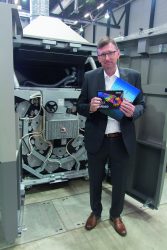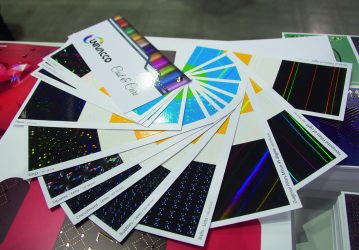This year’s biennial event for the roll-fed digital inkjet printing and finishing world attracted the largest number of visitors yet to the shores of Lake Lucerne. Michael Walker was among them.
Switzerland in February ought to be all about mountains and snow. The mountains were there alright, with snow on them, but there was precious little anywhere else as Lucerne basked in an unseasonal heatwave in the last week of the month. This setting for the thirteenth Hunkeler Innovationdays event meant that it was considerably more pleasant to step outside the Messe Luzern than usual, but there was more inside to see than ever, with 100 exhibitors, and more people there to see it too, about 6500 of them, according to the event’s organisers.

Christian Unterberger
Although it’s led by one of the big names in high-speed digital print finishing, Hunkeler Innovationdays (HID) isn’t just about finishing, as all the big names in high speed inkjet presses were there, many of them with their latest machines running throughout the four days, as well as a variety of paper mills and software suppliers.
Equipment from host Hunkeler was everywhere on the show floor, as might be expected, and the company was keen to show the latest developments in its Generation 8 products, which generally go faster and handle wider web widths while increasing automation. On-the-fly switchover at full printer speed between four- and six-page signatures or A4 to A5 format web-to-sheet cutting and folding, was shown on the Flyfolder ‘book of one’ line, with book block stacking, de-collation and offset for use with a Müller Martini perfect binder. The Flyfolder can deliver up to 900 book blocks per hour. Self-covered ‘budget binding’ options with the PF7 plough folder for parts lists or exam papers were demonstrated live, as was the CS8 cutter which can change formats from one- to four-up to in only 15 seconds.

Ricoh’s Erwin Busselot with samples printed on the Pro VC70000
For maximum productivity, the RS8 flying splice unit allows rolls of paper to be changed without having to stop printing even at up to 240m/min. This is mirrored by the TR8 turret rewinder which similarly allows for take-up rolls to be swapped without halting printing. Hunkeler also introduced the DocuTrim, its first offering for sheet-fed finishing, which cuts and perforates at up to 10,000sph; it was demonstrated running inline with a Canon Océ i300. Also featured was the HL8 laser cutter which can produce engraving and security print effects as well as cutting and perforation of stock between 60 and 500gsm, at speeds of up to around 40m/min, or on cut sheets.
Cell block
Partnering with Hunkeler and various other finishing equipment suppliers on several of its live demonstrations was Müller Martini, who showcased different book production configurations including ‘cell production’ with the Infinitrim three-knife trimmer and Vareo perfect binder. The company’s Connex automation workflow system was also presented.
Böwe Systec announced but did not show the Fusion Speed high performance inserter that can fill up to 3000 envelopes an hour. Based on the Fusion Cross system, it goes faster and can handle a range of formats from B6+ to B5 and 6 x 9in. Enclosures up to 15mm thick and 1kg in weight can be handled. The new system will be demonstrated at the company’s open day in Augsburg on May.
Canon announced a ‘heavy paper’ kit for its Océ ProStream 1000 inkjet press, allowing it to handle stock up to 300gsm for direct mail applications. A new nozzle failure compensation capability, brought across from the i300 cut-sheet press, corrects for blocked jets. This allows the press to maintain quality with no loss of print speed and miminises paper wastage. The RIP has been upgraded to 1200 x 1200dpi capability (it was 600 x 600) to match the print engine, bringing improved quality particularly for finely detailed type. This capability is standard on new ProStream 1000 models and available as an upgrade to existing installations. There were around 10 of the latter at the time of the event but this is expected to rise to 35 or more by the end of the year.
Christian Unterberger, chief marketing officer, told Digital Printer that flexibility of application would be key for high speed inkjets, including in litho replacement work. ‘There’s now new killer app for print. It’s the sum of many smaller apps,’ he said, adding that although global print volumes are growing, placements of presses are decreasing, leading to more applications per machine. Canon’s approach to media flexibility is via flood priming of papers, which Mr Unterberger says permits 200 to 300% total coverage, which ‘spot’ primer can’t support.
Another inkjet supplier that’s pushing the litho replacement argument is Ricoh, which gave the first public showing of its Pro VC70000 150m/min inkjet which it says can offer offset quality on ‘most’ paper types, including offset coated stocks. There is the usual inkjet trade-off between resolution and throughput, with the top speed being achieved at 600 x 600dpi, and only half that at top resolution of 1200 x1200 dpi. However, multiple drop sizes from Ricoh’s piezo printheads mean that fine details and smooth gradients can be rendered well even at this setting. Part of the speed is down to new ink, which can also be used in the existing VC60000 press, though that lacks the more sophisticated drying systems of the new machine and so only gains a marginal speed advantage.

Transactional, transpromo and direct mail are applications for Riso’s T1 roll-fed inkjet
Number crunchers
Ricoh also introduced new Cloud-based business intelligence software, Ricoh Supervisor, which pulls together otherwise siloed information from Ricoh and other vendors’ hardware plus software applications including MIS and workflow to give ‘dashboard’ views of overall business performance. This is complemented by Communications Manager, a customer communications management (CCM) tool that integrates with other Ricoh and third-party applications to manage workflow and customer experience.
Production metrics were also catered for by US software developer Spencer Metrics’ Connect, which provides a uniform presentation of data gathered from multiple sources and formats, including finishing equipment and DFEs from the major digital press vendors. It’s available in the UK, rebadged via Xeikon. The continuous-feed toner press manufacturer was also itself at the event, with a display based on the theme ‘the power of dry toner’. It didn’t launch any new products at the event but ran demonstrations producing large format coffee-table book covers and dust jackets on a CX500 five-colour 520mm roll-to-roll press. You can read about Xeikon’s strategy in our Supplier Insight on page 10.
HP is aiming to replace both litho and dry toner alternatives in order to support what the company’s David Murphy calls a new third category, high volume variable print. Mr Murphy told Digital Printer that with its PageWide presses, HP has the largest market share by volume of pages printed, claiming around a quarter of all inkjet pages, but pretty much like the other players who have a larger installed base, it is strongest in books, followed by transactional print and then direct mail. Commercial print remains the great untapped market for all of them, with Mr Murphy estimating that only 1–2% by volume is inkjet printed in this sector, so there is plenty to play for here, even though the market as a whole is declining.
As with every other inkjet vendor, HP is aiming to tackle the substrates limitation to provide the application flexibility that success in commercial print will need. Its approach, like Océ’s, is to prime the papers, for which purpose a new 22-in duplex priming unit, the D2200 was introduced at HID. HP claims that this expands the media possibilities to ‘thousands’ of papers and other materials and the company has launched ColorPro Media, a dedicated website to help users check what’s compatible with the T200, T300 and T400 models. The T240 HD can now handle media up to 250gsm, allowing its use for cards, tickets and marketing collateral, while productivity is increased by the Smart Mode Suite software, which enables 15% faster roll changes without losing any variable data impressions.

Samples of Cast & Cure holographic effects from the Scodix Ultra 202
Small footprints
Xerox featured its Trivor 2400 and Brenva HD inkjet presses, as well as debuting the Rialto 900MP, a roll-to-cut-sheet press with integral paper handling that combines a small footprint with up to 64m/min output to provide what the company refers to as a ‘bridge between cut-sheet and continuous feed inkjet’ offering web widths of up to 250mm. With 600dpi resolution and the narrow web, it’s targeted at transactional, transpromo and direct mail work. The HD inks are the same as in the other Impika-derived presses, allowing print onto inkjet coated/treated papers and uncoated/untreated papers.
Riso was showing its T1 roll-to-roll inkjet ‘concept’ model that first appeared at drupa 2016. The 600dpi 42m/min two-up unit has a small footprint and is aimed at transpromo and direct mail applications and at 565 A4 page equivalents per minute represents a next step up from the company’s cut-sheet inkjet models which run at 320ppm.
Scodix, now distributed in the UK by Hunkeler distributor Friedheim, was demonstrating its new Ultra 202 model launched earlier in the year. Its nine enhancement options include Cast & Cure which, by a process of film imprinting on the clear polymer that the units prints, allows diffraction and holographic effects to be achieved. Depending on the number of different effects treatments to be applied, the unit can run at up to 1250 B2 sheets per hour.
Global Graphics was displaying sample books showing the quality improvement in flat tints and subtle colour graduations that its PrintFlat online calibration service can bring to inkjet printers of all types. PrintFlat can be implemented in any inkjet RIP that has the company’s ScreenPro software installed, which includes models driven by Adobe RIPs as well as Global Graphics ones. It corrects for banding effects caused by printhead inconsistencies; samples seen by Digital Printer were convincing, and the technology has been used by German large format poster producer Ellerhold, which builds its own inkjets.





